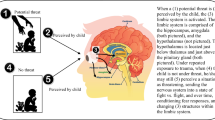Abstract
The current case study explored the clinical utility of a stimulus avoidance assessment during relaxation training with an adult with an autism spectrum disorder. A multiple stimulus without replacement procedure was implemented with aversive events to identify an aversive situation hierarchy. Aversive events were then systematically presented during the analogue phase of relaxation training across low, medium, and highly aversive events. Results support a clinical utility of using stimulus assessments to inform relaxation training, while suggesting further modifications to relaxation training protocols for generalization of skills.



Similar content being viewed by others
References
Baer. (2003). Mindfulness training as a clinical intervention: a conceptual and empirical review. Clinical Psychology: Science and Practice, 10, 125–143.
DeLeon, I. G., & Iwata, B. A. (1996). Evaluation of a multiple-stimulus presentation format for assessing reinforcer preferences. Journal of Applied Behavior Analysis, 29, 519–533.
Fisher, W., Piazza, C. C., Bowman, L. G., Hagopian, L. P., & Langdon, N. A. (1994). Empirically derived consequences: a data-based method for prescribing treatments for destructive behavior. Research in Developmental Disabilities, 15(2), 133–149.
Hayes, S. C. (2004). Acceptance and commitment therapy, relational frame theory, and the third wave of behavioral and cognitive therapies. Behavior Therapy, 35, 639–665.
Kabat-Zinn, J., Massion, A. O., Kristeller, J., Peterson, L. G., Fletcher, K. E., Pbert, L., et al. (1992). Effectiveness of a meditation-based stress reduction program in the treatment of anxiety disorders. American Journal of Psychiatry, 149, 936–943.
Manzoni, G. M., Pagnini, F., Castelnuovo, G., & Molinari, E. (2008). Relaxation training for anxiety: a ten-year systematic review with meta-analysis. BMC Psychiatry, 8, 41.
Northup, J., George, T., Jones, K., Broussard, C., & Vollmer, T. R. (1996). A comparison of reinforcer assessment methods: the utility of verbal and pictorial choice procedures. Journal of Applied Behavior Analysis, 29, 201–212.
Singh, N. N., Wahler, G. R., Adkins, A. D., & Myers, R. E. (2003). Soles of the feet: a mindfulness based self-control intervention for aggression by an individual with mild mental retardation and mental illness. Research in Developmental Disabilities, 24(3), 158–169.
Singh, N. N., Lancioni, G. E., Singh, A. D. A., Winton, A. S. W., Singh, A. N. A., & Singh, J. (2011). Adolescents with Asperger syndrome can use a mindfulness-based strategy to control their aggressive behavior. Research in Autism Spectrum Disorders, 5(3), 1103–1109.
Author information
Authors and Affiliations
Corresponding author
Additional information
Implications for Practice
• Replication of previous research involving relaxation training to decrease aggression in populations with Autism
• Development and systematic implementation of an objective aversive hierarchy through the use of MSWO assessment procedures
• Training protocol to promote client self-regulation of precursory target states and responses
• Highlights the clinical utility of using stimulus avoidance assessments to inform practice
Rights and permissions
About this article
Cite this article
Wilson, A.N., Kasson, E.M., Gratz, O. et al. Exploring the Clinical Utility of a Stimulus Avoidance Assessment to Enhance a Relaxation Training Model. Behav Analysis Practice 8, 57–61 (2015). https://doi.org/10.1007/s40617-014-0035-y
Published:
Issue Date:
DOI: https://doi.org/10.1007/s40617-014-0035-y




